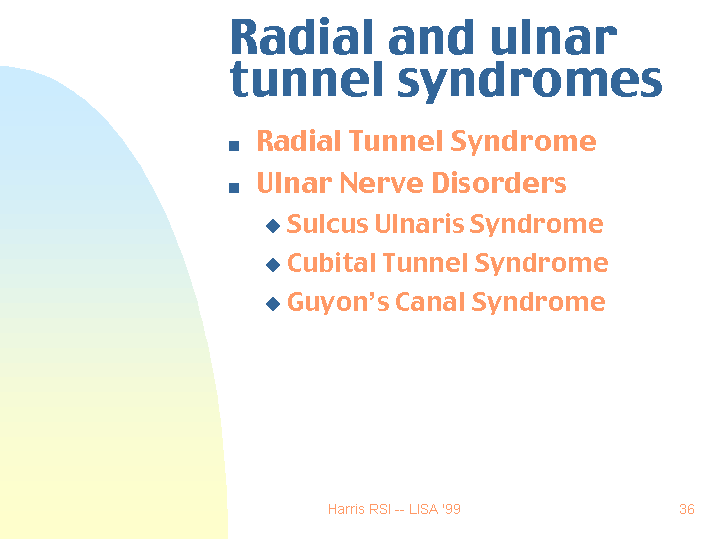Slide 36 of 75
Notes:
Radial tunnel syndrome -- compression of the radial nerve. Pain on both sides of the forearm. It can be hard to make a fist. Fingers are weakened, with thumb being last affected. Twisting motions, like wringing a dishcloth, can aggravate symptoms. Often mistaken for, or co-exists with, tennis elbow, so also called “resistant tennis elbow”. Must be treated immediately or irreversible nerve damage can occur. Surgery is indicated in some cases.
Sulcus Ulnaris Syndrome -- sulcus (furrow or groove), ulnaris (the ulna is the funny bone in the forearm). Leaning on the elbows while working can cause this. The posture can press on the ulnar nerve and cut off blood flow. Symptoms include loss of sensation, numbness, tingling, muscle atrophy, and clawlike appearance of ring and pinkie fingers. Surgery to move the nerve may be required to avoid permanent nerve damage.
Cubital tunnel syndrome -- a.k.a. flexor carpi ulnaris muscle syndrome; strikes people who work with their elbows bent at right angles for long periods of time. Involves possible nerve entrapment that occurs in the underarm. Symptoms same as above, minus clawlike ring and pinkie. Often mistaken for epicondylitis.
Guyon’s canal syndrome -- a.k.a. ulnar tunnel syndrome, is compression of the ulnar nerve in the wrist. Can be associated with trauma to the ulnar nerve caused by repeated radial deviation or dorsiflexion. Symptoms include numbness in ring and pinkie and difficulty grasping. Pain can be aggravated by both dorsiflexion and flexion. Cubital tunnel syndrome and Guyon’s canal syndrome are together called “double crush”.















